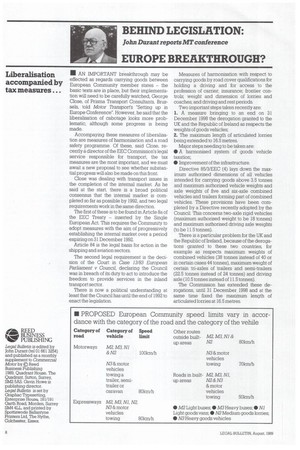BEHIND LEGISLATION:
Page 100

If you've noticed an error in this article please click here to report it so we can fix it.
John Durant reports MT conference
EUROPE BREAKTHROUGH?
In AN IMPORTANT breakthrough may be effected as regards carrying goods between European Community member states the basic texts are in place, but their implementation will need to be carefully watched, George Close, of Prisma Transport Consultants, Brussels, told Motor Transport's "Setting up in Europe Conference". However, he said that the liberalisation of cabotage looks more problematic, although some progress is being made.
Accompaying these measures of liberalisation are measures of harmonisation and a road safety programme. Of these, said Close, recently a director of the EEC Commission's legal service responsible for transport, the tax measures are the most important, and we must await a new proposal to see whether substantial progress will also be made on this front.
Close was dealing with transport issues in the completion of the internal market. As he said at the start, there is a broad political consensus that the internal market is completed so far as possible by 1992, and two legal requirements work in the same direction.
The first of these is to be found in Article 8a of the EEC Treaty inserted by the Single European Act. This requires the Community to adopt measures with the aim of progressively establishing the internal market over a period expiring on 31 December 1992.
Article 84 is the legal basis for action in the shipping and aviation sectors.
The second legal requirement is the decision of the Court in Case 13/83 European Parliament v Council, declaring the Council was in breach of its duty to act to introduce the freedom to provide services in the inland transport sector.
There is now a political understanding at least that the Council has until the end of 1992 to enact the legislation. Measures of harmonisation with respect to carrying goods by road cover qualifications for holding a driving and for access to the profession of carrier; insurance; frontier controls; weight and dimension of lorries and coaches; and driving and rest periods.
Two important steps taken recently are: 1. A measure bringing to an end on 31 December 1998 the derogation granted to the UK and the Republic of Ireland as respects the weights of goods vehicles; 2. The maximum length of articulated lorries being extended to 16.5 metres. Major steps needing to be taken are: • A harmonised system of goods vehicle taxation; • Improvement of the infrastructure.
Directive 85/3/EEC (4) lays down the maximum authorised dimensions of all vehicles intended for carrying goods above 3.5 tonnes and maximum authorised vehicle weights and axle weights of five and six-axle combined vehicles and trailers forming part of combined vehicles. These provisions have been completed by a Directive recently adopted by the Council. This concerns two-axle rigid vehicles (maximum authorised weight to be 18 tonnes) and maximum authorised driving axle weights (to be 11.5 tonnes).
There is a particular problem for the UK and the Republic of Ireland, because of the derogations granted to these two countries, for example as respects maximum weights of combined vehicles (38 tonnes instead of 40 or in certain cases 44 tonnes), maximum weight of certain tri-axles of trailers and semi-trailers (22.5 tonnes instead of 24 tonnes) and driving axle (10.5 tonnes instead of 11.5 tonnes).
The Commission has extended these derogations, until 31 December 1998 and at the same time fixed the maximum length of articulated lorries at 16.5 metres.




































































































